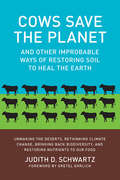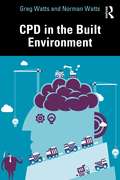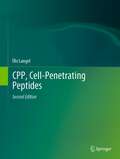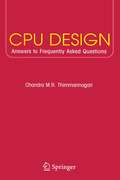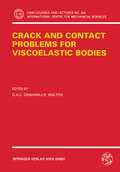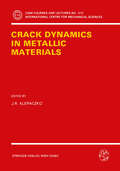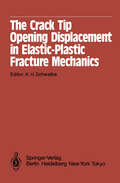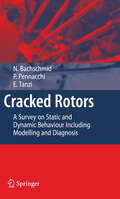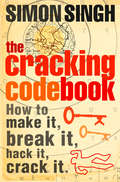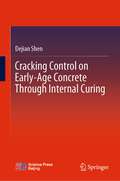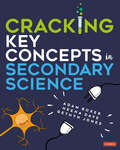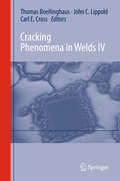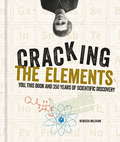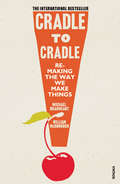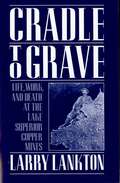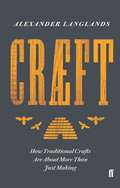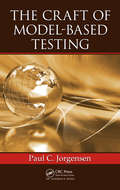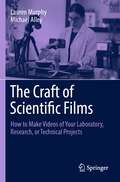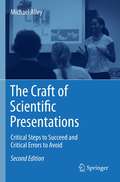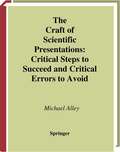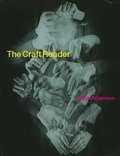- Table View
- List View
Cows Save the Planet: And Other Improbable Ways of Restoring Soil to Heal the Earth
by Judith Schwartz Gretel EhrlichIn Cows Save the Planet, journalist Judith D. Schwartz looks at soil as a crucible for our many overlapping environmental, economic, and social crises. Schwartz reveals that for many of these problems—climate change, desertification, biodiversity loss, droughts, floods, wildfires, rural poverty, malnutrition, and obesity—there are positive, alternative scenarios to the degradation and devastation we face. In each case, our ability to turn these crises into opportunities depends on how we treat the soil. Drawing on the work of thinkers and doers, renegade scientists and institutional whistleblowers from around the world, Schwartz challenges much of the conventional thinking about global warming and other problems. For example, land can suffer from undergrazing as well as overgrazing, since certain landscapes, such as grasslands, require the disturbance from livestock to thrive. Regarding climate, when we focus on carbon dioxide, we neglect the central role of water in soil—"green water"—in temperature regulation. And much of the carbon dioxide that burdens the atmosphere is not the result of fuel emissions, but from agriculture; returning carbon to the soil not only reduces carbon dioxide levels but also enhances soil fertility. Cows Save the Planet is at once a primer on soil's pivotal role in our ecology and economy, a call to action, and an antidote to the despair that environmental news so often leaves us with.
CPD in the Built Environment
by Greg Watts Norman WattsThe aim of this book is to provide a single source of information to support continuing professional development (CPD) in the built environment sector. The book offers a comprehensive introduction to the concept of CPD and provides robust guidance on the methods and benefits of identifying, planning, monitoring, actioning, and recording CPD activities. It brings together theories, standards, professional and industry requirements, and contemporary arguments around individual personal and professional development. Practical techniques and real-life best practice examples outlined from within and outside of the industry empower the reader to take control of their own built environment-related development, whilst also providing information on how to develop fellow staff members. The contents covered in this book align with the requirements of numerous professional bodies, such as the Royal Institution of Chartered Surveyors (RICS), the Institution of Civil Engineers (ICE), and the Chartered Institute of Builders (CIOB). The chapters are supported by case studies, templates, practical advice, and guidance. The book is designed to help all current and future built environment professionals manage their own CPD as well as managing the CPD of others. This includes helping undergraduate and postgraduate students complete CPD requirements for modules as part of a wide range of built environment university degree courses and current built environment professionals of all levels and disciplines who wish to enhance their careers through personal and professional development, whether due to professional body requirements or by taking control of identifying and achieving their own educational needs.
CPD in the Built Environment
by Greg Watts Norman WattsThe aim of this book is to provide a single source of information to support continuing professional development (CPD) in the built environment sector. The book offers a comprehensive introduction to the concept of CPD and provides robust guidance on the methods and benefits of identifying, planning, monitoring, actioning, and recording CPD activities. It brings together theories, standards, professional and industry requirements, and contemporary arguments around individual personal and professional development. Practical techniques and real-life best practice examples outlined from within and outside of the industry empower the reader to take control of their own built environment-related development, whilst also providing information on how to develop fellow staff members. The contents covered in this book align with the requirements of numerous professional bodies, such as the Royal Institution of Chartered Surveyors (RICS), the Institution of Civil Engineers (ICE), and the Chartered Institute of Builders (CIOB). The chapters are supported by case studies, templates, practical advice, and guidance. The book is designed to help all current and future built environment professionals manage their own CPD as well as managing the CPD of others. This includes helping undergraduate and postgraduate students complete CPD requirements for modules as part of a wide range of built environment university degree courses and current built environment professionals of all levels and disciplines who wish to enhance their careers through personal and professional development, whether due to professional body requirements or by taking control of identifying and achieving their own educational needs.
CPP, Cell-Penetrating Peptides
by Ülo LangelIn this book, a summary and update of the most important areas of cell-penetrating peptides (CPP) research are presented, while raising relevant questions for further development. The CPP sequences are presented and discussed throughout the book. The methods for testing CPP mechanisms are discussed in detail. Various approaches for the testing of endocytotic pathways of CPP uptake are also described. Different CPP uptake experiments are compared since it is becoming clear that it is often best to apply several methods in a complementary manner in order to most comprehensively evaluate CPP uptake mechanisms due to the complexity of these processes. A brief summary of functionality issues of CPPs, both in vitro and in vivo, is discussed. Therapeutic potential of CPPs and commercial developments are discussed. The present, second edition of this book is the updated and expanded version of the first edition, published in 2019. The development of the field of cell-penetrating peptides in these five years has been obvious and exciting. This second edition of the book has been partly reorganized and comprehensively expanded with the exciting research in 2019-2023. Around 2500 novel scientific articles have become available, most of them are reviewed in the second edition. Additional rapidly growing areas of high impact presented in this second edition are therapeutic developments (Chapter 16) and delivery of oligonucleotides and proteins/peptides (Chapters 5 and 6) including novel reports on genome editing with CPP assistance. Also, several additional examples are available now on clinical trials using CPPs (Chapter 15). The book is written for researchers and students in the field.
CPU Design: Answers to Frequently Asked Questions
by Chandra ThimmannagariPresents information in a user-friendly, easy-access way so that the book can act as either a quick reference for more experienced engineers or as an introductory guide for new engineers and college graduates.
Crack and Contact Problems for Viscoelastic Bodies (CISM International Centre for Mechanical Sciences #356)
by G. A. C. Graham J. R. WaltonThe main emphasis of these Lecture Notes is on constructing solutions to specific viscoelastic boundary value problems; however properties of the equations of viscoelasticity that provide the theoretical underpinnings for constructing such solutions are also covered. Particular attention is paid to the solution of crack and contact problems. This work is of interest in the context of polymer fracture, modelling of material behaviour, rebound testing of polymers and the phenomenon of hysteretic friction.
Crack Dynamics in Metallic Materials (CISM International Centre for Mechanical Sciences #310)
by J. R. KlepaczkoThis book provides an up-to-date knowledge on theory and experimental results of rate-dependent fracture processes in metallic materials. The objective is to expose the current status of a growing branch of fracture mechanics called generally "Dynamic Fracture". Crack dynamics takes into account not only the effects of inertia but also rate sensitivity of a material under consideration. This volume has been prepared by four leading authorities in fracture dynamics: D.R. Curran, J.F. Kalthoff, J.R. Klepaczko and F. Nilsson. A broad range of problem is covered: dynamic fracture theory, application of dynamic fracture mechanics, dynamic crack inition and microstatistical fracture mechanics in dynamic fracture. The book in its present format may serve as a text supplement in lecturing on fracture mechanics. On the other hand, it may serve as an instructional aid in engineering of fracture prevention.
The Crack Tip Opening Displacement in Elastic-Plastic Fracture Mechanics: Proceedings of the Workshop on the CTOD Methodology GKSS-Forschungszentrum Geesthacht, GmbH, Geesthacht, Germany, April 23–25, 1985
by K. H. SchwalbeSponsored by Studiengesellschaft zur Förderung der Kern- energieverwertung im Schiffbau und Schiffahrt e.V. (KEST), Hamburg/Stiftung Volkswagenwerk, Hannover
Cracked Rotors: A Survey on Static and Dynamic Behaviour Including Modelling and Diagnosis
by Nicoló Bachschmid Paolo Pennacchi Ezio TanziCracks can develop in rotating shafts and can propagate to relevant depths without affecting consistently the normal operating conditions of the shaft. In order to avoid catastrophic failures, accurate vibration analyses have to be performed for crack detection. The identification of the crack location and depth is possible by means of a model based diagnostic approach, provided that the model of the crack and the model of the cracked shaft dynamical behavior are accurate and reliable. This monograph shows the typical dynamical behavior of cracked shafts and presents tests for detecting cracks. The book describes how to model cracks, how to simulate the dynamical behavior of cracked shaft, and compares the corresponding numerical with experimental results. All effects of cracks on the vibrations of rotating shafts are analyzed, and some results of a numerical sensitivity analysis of the vibrations to the presence and severity of the crack are shown. Finally the book describes some crack identification procedures and shows some results in model based crack identification in position and depth. The book is useful for higher university courses in mechanical and energetic engineering, but also for skilled technical people employed in power generation industries.
The Cracking Code Book
by Simon SinghHow to make it, break it, hack it, crack it.The secret history of codes and code breaking. Simon Singh’s best-selling title The Code Book now re-issued for the young-adult market.
Cracking Control on Early-Age Concrete Through Internal Curing
by Dejian ShenThis monograph is written based on the author's research on the assessment, control, and repair of cracking of early-age concrete in the recent decade. The technique of internal curing for increasing cracking resistance of early-age concrete is further developed through experimental and theoretical research. It establishes models for predicting the internal relative humidity and autogenous shrinkage of internally cured concrete at early age; reveals the variation law and mechanism of early-age tensile creep of internally cured concrete; and explores the variation law and mechanism of early-age cracking resistance of internally cured concrete under continuous restrained condition or uniaxial restrained condition. It is designed as a reference work for professionals or practitioners and a textbook for undergraduates or postgraduates. As such, this book provides valuable knowledge, useful methods, and practical experience that can be considered in the field of concrete cracking control.
Cracking Key Concepts in Secondary Science (Corwin Ltd)
by Adam Boxer Heena Dave Gethyn JonesThe perfect companion to help you crack some of secondary science’s most challenging concepts in your teaching. Secondary science teaching is a heroic task, taking some of humanity’s greatest discoveries and explaining them to the next generation of students. Cracking some of the trickiest concepts in biology, chemistry and physics, with walkthrough explanations and examples inspired by direct instruction, this book will bring a fresh perspective to your teaching. · 30 key concepts explored in depth · Understand what students should know before and after the lesson · Tips and tricks offer detailed advice on each topic · Checks for understanding so you can test your students’ knowledge Adam Boxer is Head of Science at The Totteridge Academy in North London. Heena Dave was Head of Science at Bedford Free School. Gethyn Jones is a teacher of physics at an independent school in London
Cracking Key Concepts in Secondary Science (Corwin Ltd)
by Adam Boxer Heena Dave Gethyn JonesThe perfect companion to help you crack some of secondary science’s most challenging concepts in your teaching. Secondary science teaching is a heroic task, taking some of humanity’s greatest discoveries and explaining them to the next generation of students. Cracking some of the trickiest concepts in biology, chemistry and physics, with walkthrough explanations and examples inspired by direct instruction, this book will bring a fresh perspective to your teaching. · 30 key concepts explored in depth · Understand what students should know before and after the lesson · Tips and tricks offer detailed advice on each topic · Checks for understanding so you can test your students’ knowledge Adam Boxer is Head of Science at The Totteridge Academy in North London. Heena Dave was Head of Science at Bedford Free School. Gethyn Jones is a teacher of physics at an independent school in London
Cracking Key Concepts in Secondary Science (Corwin Ltd)
by Adam Boxer Heena Dave Gethyn JonesThe perfect companion to help you crack some of secondary science’s most challenging concepts in your teaching. Secondary science teaching is a heroic task, taking some of humanity’s greatest discoveries and explaining them to the next generation of students. Cracking some of the trickiest concepts in biology, chemistry and physics, with walkthrough explanations and examples inspired by direct instruction, this book will bring a fresh perspective to your teaching. · 30 key concepts explored in depth · Understand what students should know before and after the lesson · Tips and tricks offer detailed advice on each topic · Checks for understanding so you can test your students’ knowledge Adam Boxer is Head of Science at The Totteridge Academy in North London. Heena Dave was Head of Science at Bedford Free School. Gethyn Jones is a teacher of physics at an independent school in London
Cracking Phenomena in Welds IV
by Thomas Boellinghaus John C. Lippold Carl Edward CrossThis is the fourth volume in the well-established series of compendiums devoted to the subject of weld hot cracking. It contains the papers presented at the 4th International Cracking Workshop held in Berlin in April 2014. In the context of this workshop, the term “cracking” refers to hot cracking in the classical and previous sense, but also to cold cracking, stress-corrosion cracking and elevated temp. solid-state cracking. A variety of different cracking subjects are discussed, including test standards, crack prediction, weldability determination, crack mitigation, stress states, numerical modelling, and cracking mechanisms. Likewise, many different alloys were investigated such as aluminum alloys, copper-aluminum dissimilar metal, austenitic stainless steel, nickel base alloys, duplex stainless steel, creep resistant steel, and high strength steel.
Cracking the Elements (Cracking Series)
by Rebecca MilehamFrom the earliest-known elements to those named in 2016, this book takes a comprehensive look at the development of the periodic table - and reveals untold stories, unsung pioneers and plenty of fascinating science along the way. In twelve illustrated chapters, the book makes sense of the patterns and groups within the periodic table, introducing each of the 118 known elements individually and exploring questions including:- Why did the history of fizzy water give early chemistry a sparkle?- How did hydrogen reveal the structure of the atom?- What was the Bunsen burner's role in discovering new elements?- Which of the alkaline earth metals accounts for a kilogramme of your weight?- Why is Marie Curie such a scientific star?- How do tungsten and vanadium explain the secret of super-sharp Syrian swords?- Who discovered the most elements in the periodic table?- What made nihonium, element 113, such a wonderful new year's gift for Japan?- Is glass a liquid or a solid?- How did nitrogen fulfill the alchemists' dream?- Would you have smeared antimony on your face if you'd lived in ancient Egypt?- Why might naked mole rats have clues for surviving a heart attack?- How did the Haya people of Tanzania make steel 1500 years ago?- What makes xenon a great anaesthetic - and why can't all patients use it?- Might there be a pattern in yet undiscovered elements beyond number 118?
Cradle to Cradle: (Patterns of the Planet) (Patterns Of Life Ser.)
by Michael Braungart William McDonoughRecycling is good, isn’t it? In this visionary book, chemist Michael Braungart and architect William McDonough challenge this status quo and put forward a manifesto for an intriguing and radically different philosophy of environmentalism."Reduce, reuse, recycle”. This is the standard “cradle to grave” manufacturing model dating back to the Industrial Revolution that we still follow today. In this thought-provoking read, the authors propose that instead of minimising waste, we should be striving to create value. This is the essence of Cradle to Cradle: waste need not to exist at all. By providing a framework of redesign of everything from carpets to corporate campuses, McDonough and Braungart make a revolutionary yet viable case for change and for remaking the way we make things.
Cradle to Grave: Life, Work, and Death at the Lake Superior Copper Mines
by Larry LanktonConcentrating on technology, economics, labor, and social history, Cradle to Grave documents the full life cycle of one of America's great mineral ranges from the 1840s to the 1960s. Lankton examines the workers' world underground, but is equally concerned with the mining communities on the surface. For the first fifty years of development, these mining communities remained remarkably harmonious, even while new, large companies obliterated traditional forms of organization and work within the industry. By 1890, however, the Lake Superior copper industry of upper Michigan started facing many challenges, including strong economic competition and a declining profit margin; growing worker dissatisfaction with both living and working conditions; and erosion of the companies' hegemony in a district they once controlled. Lankton traces technological changes within the mines and provides a thorough investigation of mine accidents and safety. He then focuses on social and labor history, dealing especially with the issue of how company paternalism exerted social control over the work force. A social history of technology, Cradle to Grave will appeal to labor, social and business historians.
Craeft: How Traditional Crafts Are about More than Just Making
by Alexander LanglandsIn the modern world we are becoming bombarded by craft. Hand-made tools, artisan breads and craft beers are all part of a pantheon of goods designed to appeal to our earthier selves, our sense of tradition, quality and luxury, all brought together through a personal touch - objects to savour in a world of meaningless mass manufacture. But once, craft - or more specifically, cræft - meant something very different. When it was first written down in Old English, over a thousand years ago, it had an almost indefinable sense of 'knowledge', 'wisdom' and 'power'. To be cræfty was to be truly intelligent - but in a way that is almost inconceivable to us today. Through a series of mini-histories, detailed craft analyses and personal anecdotes, archaeologist, historian and broadcaster Alex Langlands goes in search of the lost knowledge of cræft. Fusing stories of landscapes, personalities and mesmerising skill, with back-breaking hard work, this book will convince readers - for their health, wealth and well-being - to introduce more cræft into their lives.
The Craft of Model-Based Testing
by Paul C. JorgensenIn his latest work, author Paul C Jorgensen takes his well-honed craftsman’s approach to mastering model-based testing (MBT). To be expert at MBT, a software tester has to understand it as a craft rather than an art. This means a tester should have deep knowledge of the underlying subject and be well practiced in carrying out modeling and testing techniques. Judgment is needed, as well as an understanding of MBT the tools. The first part of the book helps testers in developing that judgment. It starts with an overview of MBT and follows with an in-depth treatment of nine different testing models with a chapter dedicated to each model. These chapters are tied together by a pair of examples: a simple insurance premium calculation and an event-driven system that describes a garage door controller. The book shows how simpler models—flowcharts, decision tables, and UML Activity charts—express the important aspects of the insurance premium problem. It also shows how transition-based models—finite state machines, Petri nets, and statecharts—are necessary for the garage door controller but are overkill for the insurance premium problem. Each chapter describes the extent to which a model can support MBT. The second part of the book gives testers a greater understanding of MBT tools. It examines six commercial MBT products, presents the salient features of each product, and demonstrates using the product on the insurance premium and the garage door controller problems. These chapters each conclude with advice on implementing MBT in an organization. The last chapter describes six Open Source tools to round out a tester’s knowledge of MBT. In addition, the book supports the International Software Testing Qualifications Board’s (ISTQB®) MBT syllabus for certification.
The Craft of Model-Based Testing
by Paul C. JorgensenIn his latest work, author Paul C Jorgensen takes his well-honed craftsman’s approach to mastering model-based testing (MBT). To be expert at MBT, a software tester has to understand it as a craft rather than an art. This means a tester should have deep knowledge of the underlying subject and be well practiced in carrying out modeling and testing techniques. Judgment is needed, as well as an understanding of MBT the tools. The first part of the book helps testers in developing that judgment. It starts with an overview of MBT and follows with an in-depth treatment of nine different testing models with a chapter dedicated to each model. These chapters are tied together by a pair of examples: a simple insurance premium calculation and an event-driven system that describes a garage door controller. The book shows how simpler models—flowcharts, decision tables, and UML Activity charts—express the important aspects of the insurance premium problem. It also shows how transition-based models—finite state machines, Petri nets, and statecharts—are necessary for the garage door controller but are overkill for the insurance premium problem. Each chapter describes the extent to which a model can support MBT. The second part of the book gives testers a greater understanding of MBT tools. It examines six commercial MBT products, presents the salient features of each product, and demonstrates using the product on the insurance premium and the garage door controller problems. These chapters each conclude with advice on implementing MBT in an organization. The last chapter describes six Open Source tools to round out a tester’s knowledge of MBT. In addition, the book supports the International Software Testing Qualifications Board’s (ISTQB®) MBT syllabus for certification.
The Craft of Scientific Films: How to Make Videos of Your Laboratory, Research, or Technical Projects
by Lauren Murphy Michael AlleyThis book, the first of its kind, helps scientists and engineers of all stages and disciplines share their work in a new way—with movies. Today, much of scientific communication is embedded in papers and presentations, but these documents don’t often extend outside of a specific academic field. By adding movies as a medium of communication, scientists and engineers can better communicate with their colleagues while also increasing their reach to students, professors, peers, potential collaborators, and the public. Scientific films help translate complex technical topics into more accessible and consumable messages. By following Lauren Murphy’s filmmaking formula – planning, shooting, and editing – readers will create their very own scientific films that look professional and polished. Using tools as simple as a smartphone, readers can develop short, personal stories with no cost or experience needed. This book will guide readers through all steps of the movie making process to a finished product. Readers will evolve their creative thinking skills and use their movies to improve classroom presentations, network across student organizations, present at conferences, recruit students for their labs, secure grant money, and more. Adding a movie to your body of work can be the tool that sparks interest in audiences to learn more—driving traffic to your publications, research projects, and websites. This book will help you develop new skills to become a better communicator while spreading your ideas and research to new audiences.
The Craft of Scientific Presentations: Critical Steps to Succeed and Critical Errors to Avoid
by Michael AlleyThe Craft of Scientific Presentations, 2nd edition aims to strengthen you as a presenter of science and engineering. The book does so by identifying what makes excellent presenters such as Brian Cox, Jane Goodall, Richard Feynman, and Jill Bolte Taylor so strong. In addition, the book explains what causes so many scientific presentations to flounder.One of the most valuable contributions of this text is that it teaches the assertion-evidence approach to scientific presentations. Instead of building presentations, as most engineers and scientists do, on the weak foundation of topic phrases and bulleted lists, this assertion-evidence approach calls for building presentations on succinct message assertions supported by visual evidence. Unlike the commonly followed topic-subtopic approach that PowerPoint leads presenters to use, the assertion-evidence approach is solidly grounded in research.By showing the differences between strong and weak presentations, by identifying the errors that scientific presenters typically make, and by teaching a much more powerful approach for scientific presentations than what is commonly practiced, this book places you in a position to elevate your presentations to a high level. In essence, this book aims to have you not just succeed in your scientific presentations, but excel.About the AuthorMichael Alley has taught workshops on presentations to engineers and scientists on five continents, and has recently been invited to speak at the European Space Organization, Harvard Medical School, MIT, Sandia National Labs, Shanghai Jiao Tong University, Simula Research Laboratory, and United Technologies. An Associate Professor of engineering communication at Pennsylvania State University, Alley is a leading researcher on the effectiveness of different designs for presentation slides.
The Craft of Scientific Presentations: Critical Steps to Succeed and Critical Errors to Avoid
by Michael AlleyThis timely and hugely practical work provides a score of examples from contemporary and historical scientific presentations to show clearly what makes an oral presentation effective. It considers presentations made to persuade an audience to adopt some course of action (such as funding a proposal) as well as presentations made to communicate information, and it considers these from four perspectives: speech, structure, visual aids, and delivery. It also discusses computer-based projections and slide shows as well as overhead projections. In particular, it looks at ways of organizing graphics and text in projected images and of using layout and design to present the information efficiently and effectively.
The Craft Reader (PDF)
by Glenn AdamsonFrom the canonical texts of the Arts and Crafts Movement to the radical thinking of today's "DIY" movement, from theoretical writings on the position of craft in distinction to Art and Design to how-to texts from renowned practitioners, from feminist histories of textiles to descriptions of the innovation born of necessity in Soviet factories and African auto-repair shops...The Craft Reader presents the first comprehensive anthology of writings on modern craft. Covering the period from the Industrial Revolution to today, the Reader draws on craft practice and theory from America, Europe, Asia and Africa. The world of craft is considered in its full breadth -- from pottery and weaving, to couture and chocolate-making, to contemporary art, architecture and curation. The writings are themed into sections and all extracts are individually introduced, placing each in its historical, cultural and artistic context. Bringing together an astonishing range of both classic and contemporary texts, The Craft Reader will be invaluable to any student or practitioner of Craft and also to readers in Art and Design. AUTHORS INCLUDE: Theodor Adorno, Anni Albers, Amadou Hâmpaté Bâ, Charles Babbage, Roland Barthes, Andrea Branzi, Alison Britton, Rafael Cardoso, Johanna Drucker, Charles Eames, Salvatore Ferragamo, Kenneth Frampton, Alfred Gell, Walter Gropius, Tanya Harrod, Martin Heidegger, Patrick Heron, Bernard Leach, Esther Leslie, W. R. Lethaby, Lucy Lippard, Adolf Loos, Karl Marx, William Morris, Robert Morris, László Moholy-Nagy, Stefan Muthesius, George Nakashima, Octavio Paz, Grayson Perry, M. C. Richards, John Ruskin, Raphael Samuel, Ellen Gates Starr, Debbie Stoller, Alexis de Tocqueville, Lee Ufan, Frank Lloyd Wright.
